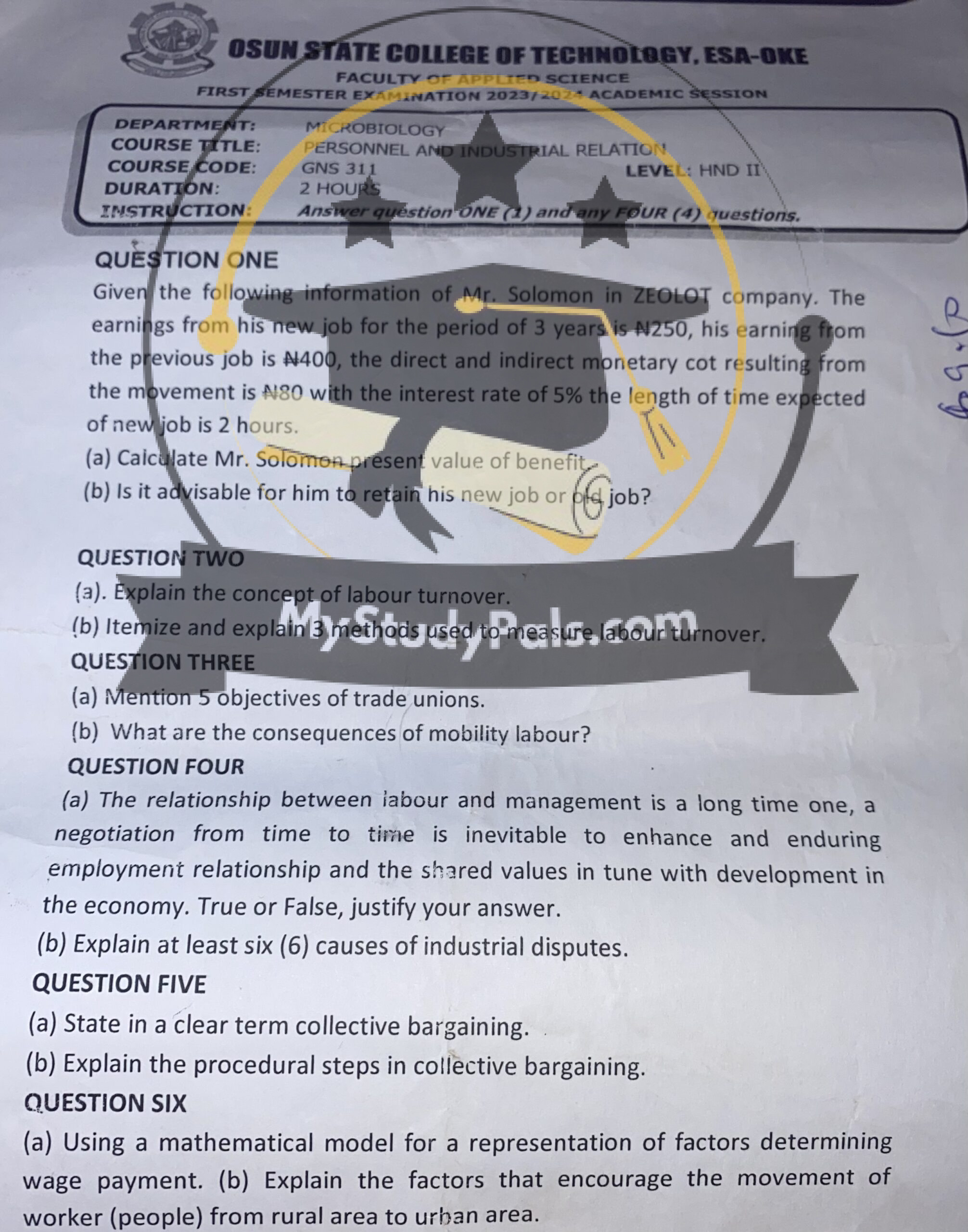ANWSER
Sure! Here are the answers to the exam questions in the requested format:
QUESTION ONE:
(a) Calculate Mr. Solomon’s present value of benefit.
To calculate the present value (PV) of Mr. Solomon’s benefit, we use the formula:
PV=FV(1+r)tPV = \frac{FV}{(1 + r)^t}
Where:
- FV = Future Value = N250−N400−N80=−N230N250 – N400 – N80 = -N230 (since he is earning less and incurring costs)
- r = Interest rate = 5% (0.05)
- t = Number of years = 3
PV=−230(1.05)3PV = \frac{-230}{(1.05)^3} PV=−2301.157625PV = \frac{-230}{1.157625} PV≈−N198.72PV ≈ -N198.72
(b) Should he retain his new job or old job?
Since the present value is negative (-N198.72), Mr. Solomon is financially worse off in his new job. It would be advisable for him to retain his old job.
QUESTION TWO:
(a) Explain the concept of labour turnover.
Labour turnover refers to the rate at which employees leave an organization and are replaced by new employees over a given period. It is used as an indicator of job stability and employee retention in a company.
(b) Itemize and explain three methods used to measure labour turnover.
- Separation Rate – The number of employees who leave the company during a period divided by the average number of employees, expressed as a percentage.
- Replacement Rate – The number of new employees hired to replace those who left, showing the ability of the company to maintain workforce levels.
- Total Labour Turnover Rate – The total number of employees who left and were replaced, divided by the average workforce size.
QUESTION THREE:
(a) Mention five objectives of trade unions.
- To protect the rights and welfare of workers.
- To negotiate better wages and working conditions.
- To provide legal support for workers.
- To ensure job security.
- To promote industrial peace and harmony.
(b) What are the consequences of mobility labour?
- Skill Shortages – A high level of skilled labour migration can cause shortages in some sectors.
- Economic Imbalance – Some regions may suffer due to an exodus of skilled workers.
- Increased Unemployment in Some Areas – While some areas benefit from incoming labour, others may experience higher unemployment.
- Cultural and Social Changes – Movement of labour can alter cultural dynamics in certain regions.
- Higher Training Costs – Companies may need to invest more in training new employees.
- Labour Market Disruptions – Constant movement can affect job stability and market efficiency.
QUESTION FOUR:
(a) True or False: The relationship between labour and management requires negotiation. Justify your answer.
True – Labour and management often have conflicting interests, and negotiation helps to resolve disputes, ensure fair wages, and improve working conditions while maintaining productivity and profitability.
(b) Explain at least six causes of industrial disputes.
- Low Wages – Disputes arise when workers feel underpaid.
- Poor Working Conditions – Unsafe and unfavorable work environments lead to strikes.
- Lack of Job Security – Uncertain employment can cause unrest.
- Poor Management Practices – Autocratic leadership often results in conflicts.
- Discrimination and Unfair Treatment – Unequal treatment based on gender, race, or position leads to disputes.
- Delays in Payment – Late salaries and unpaid benefits often trigger industrial actions.
QUESTION FIVE:
(a) State in clear terms collective bargaining.
Collective bargaining is the negotiation process between employers and representatives of employees (trade unions) to determine fair wages, working conditions, and other employment terms.
(b) Explain the procedural steps in collective bargaining.
- Preparation – Both parties gather data and prepare their demands.
- Negotiation – Formal discussions occur to reach a mutual agreement.
- Agreement Drafting – A written document is prepared outlining agreed terms.
- Ratification – The agreement is approved by both employers and employees.
- Implementation – The terms are enforced in the workplace.
- Review and Renegotiation – The agreement is revisited periodically for adjustments.
QUESTION SIX:
(a) Using a mathematical model, represent the factors determining wage payment.
A general wage determination model is:
W=f(S,D,P,I,U)W = f(S, D, P, I, U)
Where:
- W = Wage rate
- S = Skill level of workers
- D = Demand for labour
- P = Productivity of workers
- I = Industry profitability
- U = Union influence
(b) Explain the factors that encourage the movement of workers from rural to urban areas.
- Better Job Opportunities – Higher wages and more employment options in cities.
- Improved Living Standards – Access to better healthcare, education, and housing.
- Modern Infrastructure – Availability of electricity, water, and transportation.
- Social and Economic Development – Urban areas offer better business and economic activities.
- Higher Educational Institutions – People move to urban areas for better education and training.
- Technological Advancements – Industries in cities provide high-tech job opportunities.


